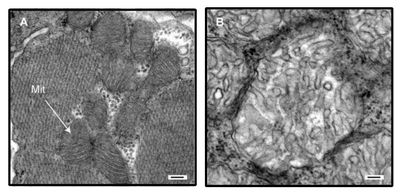O’Brien 2019 Abstract IOC139
| O’Brien KM (2019) Mitochondrial form and function in Antarctic fishes. Mitochondr Physiol Network 24.01. |
Link: IOC139
O’Brien KM (2019)
Event: IOC139
Oxidative and cardiac muscles of Antarctic icefishes, lacking the O2-binding proteins hemoglobin and myoglobin, possess mitochondria markedly different in ultrastructure compared to red-blooded and red-hearted species. Mitochondria of icefishes are enlarged with lower cristae densities compared to red-blooded fishes [1]. We hypothesized that the differences in ultrastructure would correlate with differences in function. However, despite their unusual mitochondrial architecture, the function of mitochondria from icefishes is similar to that of red-blooded species with state II and III respiration rates equivalent between the icefish, Chaenocephalus aceratus and the red-blooded species, Notothenia coriiceps [2]. Most notable is the lower rate of cytochrome c oxidase activity (per mg mitochondrial protein) and absence of the mitochondrial sarcomeric isoform of creatine kinase (CK) in C. aceratus [3], which together likely contribute to their lower ATP levels per g tissue, and perhaps cardiac performance, compared to N. coriiceps. Questions remain about what regulates mitochondrial architecture, and how it is influenced by the expression of O2- binding proteins in Antarctic fishes.
• Bioblast editor: Plangger M
Labels: MiParea: Respiration, mt-Structure;fission;fusion, Comparative MiP;environmental MiP
Organism: Fishes
Tissue;cell: Heart
Enzyme: Complex IV;cytochrome c oxidase
HRR: Oxygraph-2k
Affiliations
- Univ Alaska Fairbanks, Institute Arctic Biol, Fairbanks, AK, USA
Figures
Figure 1: Transmission electron micrographs of mitochondria from heart ventricles of the red-blooded species, N. coriiiceps (A) and icefish, C. aceratus (B). Magnification = 75,700X, Bar = 100 nm.
References
- O'Brien KM, Sidell BD (2000) The interplay among cardiac ultrastructure, metabolism and the expression of oxygen-binding proteins in Antarctic fishes. J Exp Biol 203:1287-97.
- O'Brien KM, Egginton SE, Farrell AP, Crockett EL, Schlauch K, Woolsey R, Hoffman M, Merriman S (2018) Cardiac mitochondrial metabolism may contribute to differences in thermal tolerance of red- and white-blooded Antarctic notothenioid fishes. J Exp Biol 221.
- O'Brien KM, Mueller IA, Orczewska JI, Dullen KR, Ortego M (2014) Hearts of some Antarctic fishes lack mitochondrial creatine kinase. Comp Biochem Phys A 178:30-36.
